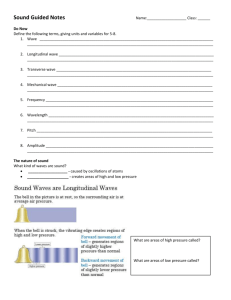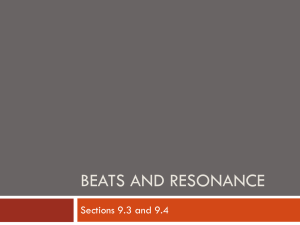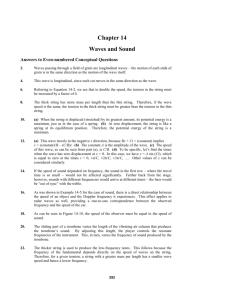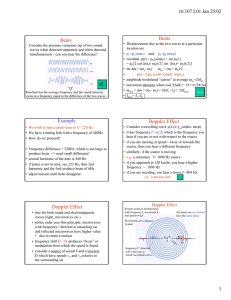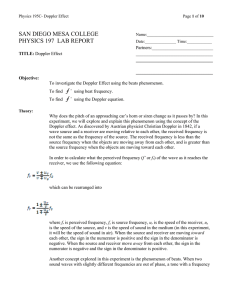Lecture 3
advertisement
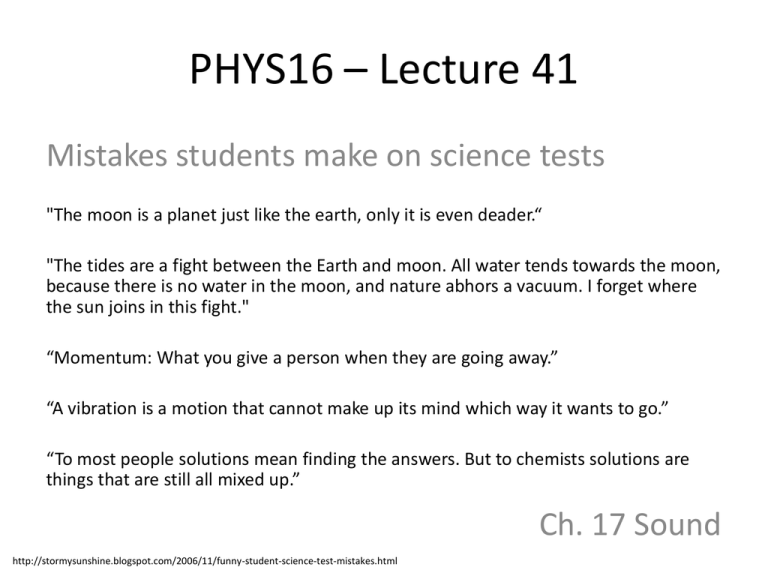
PHYS16 – Lecture 41 Mistakes students make on science tests "The moon is a planet just like the earth, only it is even deader.“ "The tides are a fight between the Earth and moon. All water tends towards the moon, because there is no water in the moon, and nature abhors a vacuum. I forget where the sun joins in this fight." “Momentum: What you give a person when they are going away.” “A vibration is a motion that cannot make up its mind which way it wants to go.” “To most people solutions mean finding the answers. But to chemists solutions are things that are still all mixed up.” Ch. 17 Sound http://stormysunshine.blogspot.com/2006/11/funny-student-science-test-mistakes.html Ch. 17 Sound • Sound – Longitudinal Pressure Waves – Sound Velocity – Sound Reflection and Standing Waves – Intensity • Beats • Doppler Sound Intensity • Intensity is the power per unit area in a wave P I , A E 1 2 2 P A v A t 2 http://hyperphysics.phy-astr.gsu.edu/hbase/acoustic/imgaco/isc2.gif Beats • Beats occur when two sine waves (two notes) with very similar frequency interfere Y t Y t I t 1 f avg ( f1 f 2 ) 2 f Beat f1 f 2 Discussion: Beats • What is the beat frequency between 440 Hz and 442 Hz? How many beats in 10 seconds? • What is the beat frequency between 440 Hz and 2 Hz? Can you hear this? • Using beats, how would you tune a piano? • Why don’t you get beats when you play two guitar strings? Doppler Effect Doppler Effect • Frequency of sound changes when relative velocity changes – Frequencies on approach sound higher – Frequencies that recede sound lower • Need to know (source/observer) and (approach/ recede) Doppler Effect • If observer receding then negative • If source receding then negative f hear vsound vOBSERVER f actual vsound vSOURCE Demo: Tuning Fork http://hyperphysics.phy-astr.gsu.edu/hbase/music/tunfor.html Example Question • The frequency of an ambulance siren is 1200 Hz. The ambulance is going 60 mph (26.8 m/s). As the ambulance approaches your stopped car, you hear what frequency? fapproach = 1300 Hz Main Points - Sound • Sound– a longitudinal pressure wave that moves through a medium • Velocity – 343 m/s in air v T , except in 3D • Reflection – occurs when medium changes – either tension between molecules or density • Resonance and Standing Waves – depends on open/closed ends 2L , n 1,2,3... both open or closed n Main Points - Sound • Intensity and Sound Level I 10 log( ), I 0 10 12 W/m 2 I0 • Interference and Beats f Beat f1 f 2 • Doppler Effect 1 f actual f approach 1 v v object sound Review Question 1 • A mechanical wave has the following measured values: Amplitude = 0.40 N/m^2 Frequency = 2.0E3 Hz Intensity = 6.0E-3 W/m^2 Phase Angle = 3π/2 rad Wavelength = 2.5 m • What is the speed at which this wave travels? A) 1.9 m/s B) 4.2E2 m/s C) 5.0E3 m/s D) 9.4E3 m/s E) None of the above. Question 2 • A large cylindrical tank filled with water is 10 m deep and has an inside diameter of 5 m. A drain pipe projects horizontally from the bottom of the tank side and has a valve that can be opened to rapidly empty the tank. The pipe has a length of 1 m and is tapered, with a cross section of 0.2 m^2 next to the tank and 0.1 m^2 at the other end. A) At the top of the tank B) At the bottom of the tank C) At the wide end of the pipe D) At the narrow end of the pipe E) None of the above Question 3 • Two mechanical waves of the same frequency pass through the same medium. The amplitude of wave A is 3 m, and the amplitude of wave B is 5 m. Which of the following describes the range of amplitudes possible when the 2 waves pass through the medium simultaneously? A) Always 4 m B) Between 2 and 8 m C) Between 3 and 5 m D) Between 5 and 8 m E) None of the above Question 4 • At the second position where all the waveforms intersect, the waveforms are all: A) in phase B) out of phase C) at a node D) at maximum amplitude E) None of the above Question 5 • A mass (M = 2.0 kg) slides with speed (v = 4.0 m/s) along a horizontal tabletop with negligible friction. It collides inelastically with a bumper plate of mass (m = 0.20 kg) and sticks to the plate. The bumper plate is attached to a horizontal spring fastened to a wall with a spring constant, k = 0.30 N/m. The bumper plate is originally at rest at the spring equilibrium position. What is the period of oscillation of the mass/bumper system? A) 2.7 s B) 11 s C) 17 s D) 19 s E) None of the above Question 6 • A stationary receiver detects a change in frequency of the signal from a jet flying directly away from it at 300 m/s. Which of the following receivers will detect the same change in frequency from a jet moving away at 600 m/s? A) A receiver moving at 900 m/s in the opposite direction as the jet B) A receiver moving at 300 m/s in the opposite direction as the jet C) A stationary receiver D) A receiver moving at 300 m/s in the same direction as the jet E) None of the above Question 7 • What is the expression for the angular frequency, ω, of a pendulum of length, L, with a bob on the end of mass, m, and at an angle of θ? A) 2mg L B) L g C) 2 L g D) g L E) None of the above Question 8 • Which of the following best explains why ultrasonic waves are reflected at boundaries within a human body? A) Reflections occur at the boundary between objects with different shapes. B) Reflections occur at the boundary between objects with different densities. C) Reflections occur when the frequency of the ultrasonic wave decreases. D) Reflections occur when the frequency of the ultrasonic wave increases. E) None of the above Question 9 • When a trumpet is tuned by comparison with a 512-Hz note from a piano, a beat frequency of 4 Hz is produced. The trumpet could have produced which of the following pairs of frequencies? A) 508 Hz and 516 Hz B) 508 Hz and 512 Hz C) 504 Hz and 508 Hz D) 512 Hz and 516 Hz E) None of the above Question 10 • What is the magnitude of the restoring force for a pendulum of length, 3 m, with a bob on the end of mass, 2 kg, and at an angle of 10 degrees? A) 20 N B) 19 N C) 4 N D) 3 N E) None of the above Essay Question • Using a tuning fork how would you tune a piano? • Physically, why might it be easier to swim in the ocean than in a lake? Is this the case? • Would it be easier to send up a satellite from Mars or the Earth? Why? Goals for the Semester 1) Introduce you to the physics of motion, force, and energy, AND some of its applications (fluids, waves, gravitation) 2) Prepare you for the MCAT 3) Show you how physics applies in your every day lives.

